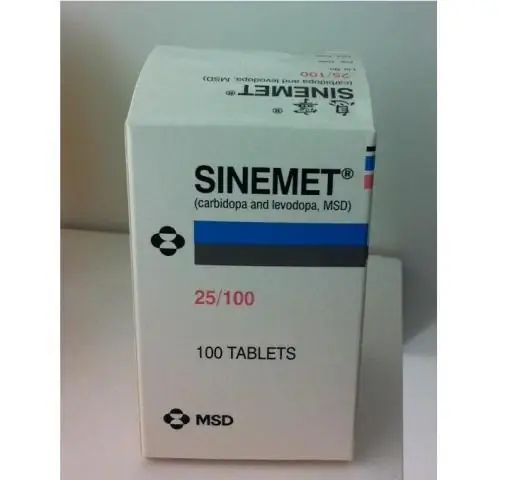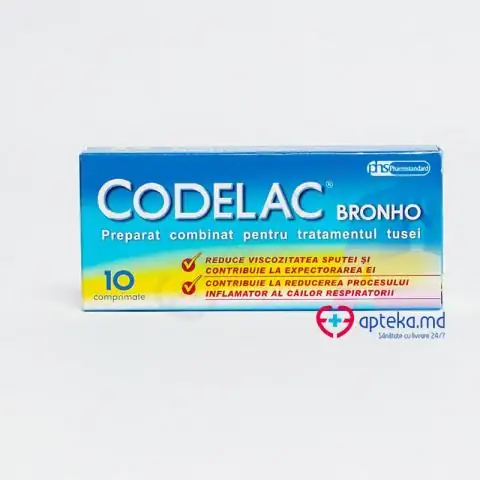- Author Rachel Wainwright [email protected].
- Public 2023-12-15 07:39.
- Last modified 2025-11-02 20:14.
Carbidopa / Levodopa
Carbidopa / Levodopa: instructions for use and reviews
- 1. Release form and composition
- 2. Pharmacological properties
- 3. Indications for use
- 4. Contraindications
- 5. Method of application and dosage
- 6. Side effects
- 7. Overdose
- 8. Special instructions
- 9. Application during pregnancy and lactation
- 10. Use in childhood
- 11. In case of impaired renal function
- 12. For violations of liver function
- 13. Use in the elderly
- 14. Drug interactions
- 15. Analogs
- 16. Terms and conditions of storage
- 17. Terms of dispensing from pharmacies
- 18. Reviews of Carbidopa / Levodopa
- 19. The price of Carbidopa / Levodopa in pharmacies
Latin name: Carbidopa / Levodopa
ATX code: N.04. BA02
Active ingredient: Levodopa + Carbidopa (Levodopa + Carbidopa)
Manufacturer: Remedica, Ltd. (Remedica, Ltd.) (Cyprus)
Description and photo update: 2019-12-07

Carbidopa / Levodopa is a combined antiparkinsonian drug (peripheral decarboxylase inhibitor + dopamine precursor).
Release form and composition
The drug is available in the form of tablets: biconvex, oval, light blue, interspersed with a darker or lighter shade, with the manufacturer's logo on one side and a line on the other (10 pcs. In blisters, in a cardboard box 10 blisters and Instructions for use of Carbidopa / Levodopa).
Composition for one tablet:
- active ingredients: carbidopa (in the form of monohydrate) - 25 mg, levodopa - 250 mg;
- auxiliary components: colloidal silicon dioxide, purified talc, microcrystalline cellulose, disodium edetate, povidone, magnesium stearate, sodium carboxymethyl starch, glycerol, E110 (sunset yellow dye), E133 (brilliant blue dye).
Pharmacological properties
Pharmacodynamics
Levodopa is an amino acid that is derived from L-tyrosine. Dopamine is formed directly from levodopa under the action of aromatic L-amino acid decarboxylase, which inhibits neuronal activity in the striatum of the brain. In peripheral tissues, the process of decarboxylation of levodopa and its conversion to dopamine also proceeds, which, however, does not pass through the blood-brain barrier.
Carbidopa inhibits the conversion of levodopa to dopamine in peripheral tissues, but does not affect this process in the central nervous system, that is, due to the combined use of these two substances, it is possible to increase the amount of levodopa that enters the brain. Co-administration with carbidopa increases the bioavailability of levodopa by 2 times. Carbidopa does not completely suppress dopa decarboxylase.
Pharmacokinetics
Levodopa
The absorption of levodopa from the gastrointestinal tract, as well as the passage of the substance through the blood-brain barrier, is carried out by active transport. Dopa decarboxylase, which is found in the intestinal wall, interferes with the absorption of levodopa. The absorption of levodopa from the stomach is limited. The rate of gastric emptying plays a key role in this process, therefore, in the presence of factors that slow down the release of the stomach, for example, when eating or m-anticholinergic drugs, the movement of the substance into the duodenum is delayed, and its absorption slows down. In the blood plasma, the maximum concentration of levodopa is observed 1-2 hours after taking Carbidopa / Levodopa.
The volume of distribution in the body is from 0.9 to 1.6 l / kg. If dopa-decarboxylase activity persists, the total clearance of levodopa from plasma is 0.5 L / kg / h. The mechanism of penetration through the blood-brain barrier is facilitated diffusion. In the endothelium of the capillaries of the brain, there is a second potential barrier for the entry of levodopa into the brain tissue - the enzyme dopa-decarboxylase, but in these capillaries only a small amount of taken levodopa is decarboxylated.
About 70-75% of levodopa taken orally is metabolized in the intestinal walls (the so-called primary passage effect). The liver is practically not involved in primary metabolism. With an increase in the dose, the amount of the drug that is decarboxylated in the intestine decreases. Levodopa does not bind to plasma proteins. The main pathway for dopamine formation is the decarboxylation of levodopa under the influence of dopa decarboxylase, the largest amounts of which are present in the liver, kidneys and intestines. The second metabolic pathway of levodopa is methoxylation by catechol-O-methyltransferase. As a result of this process, 3-O-methyldopa is formed. With prolonged therapy, this metabolite is able to accumulate. An additional metabolic pathway is the transamination of levodopa. Its end products are vinyl acetate, vinyl pyruvate and 2.4,5-trihydroxyphenylacetic acid. Transamination is the only reversible metabolic pathway.
Carbidopa increases the T 1/2 (half-life) of levodopa to 3 hours. About 69% of the substance is found in urine in the form of dopamine, as well as its metabolites - norepinephrine, dihydrophenylacetic acid, vanillin mandelic acid and homovanillic acid.
Carbidopa
When carbidopa is used in recommended doses, it does not cross the blood-brain barrier. The maximum plasma concentration is observed 2-4 hours after taking the drug. About 50% of the substance is excreted in feces and urine, while up to 35% of carbidopa, which is excreted by the kidneys, is excreted unchanged.
Indications for use
Carbidopa / Levodopa is used in patients with Parkinson's disease and Parkinson's syndrome of known origin, including those due to cerebrovascular changes, encephalitis and poisoning with toxic substances, including manganese or carbon monoxide.
Contraindications
Absolute:
- skin diseases of unknown origin;
- suspicion of melanoma or existing melanoma;
- chorea of Huntington;
- severe neurosis or psychosis;
- secondary parkinsonism due to the use of neuroleptics (antipsychotic drugs);
- benign (essential) tremor;
- angle-closure glaucoma;
- children and adolescents up to 18 years old;
- During pregnancy and breastfeeding;
- simultaneous use of non-selective MAO inhibitors (monoamine oxidase), as well as an interval of less than two weeks after the end of their intake;
- hypersensitivity to the main or auxiliary components of the drug.
Relative (Carbidopa / Levodopa tablets are used with caution):
- severe kidney and / or liver dysfunction;
- severe cardiovascular disease (heart failure, myocardial infarction with a history of heart rhythm disturbances);
- erosive and ulcerative lesions of the duodenum and / or stomach;
- severe lung diseases (including bronchial asthma);
- endocrine system diseases (including diabetes mellitus);
- mental disorders;
- a history of epileptic seizures.
Carbidopa / Levodopa, instructions for use: method and dosage
Carbidopa / Levodopa tablets are taken orally, after meals or at the same time with a small amount of food, without chewing and drinking plenty of water. Since there is competition for the absorption of levodopa and aromatic amino acids, it is not recommended to consume large amounts of protein foods during treatment.
On average, the daily dose of carbidopa, which is required to suppress the peripheral decarboxylation of levodopa, ranges from 70 to 100 mg. With an increase in the dose of carbidopa to 200 mg and above, further enhancement of the therapeutic effect does not occur. The daily dose of levodopa should not exceed 2000 mg.
At the beginning of treatment, the drug is taken 1/2 tablet twice a day. Then, if necessary, the dose is increased by 1/2 tablet per day. Usually, at the beginning of replacement therapy, the daily dose of Carbidopa / Levodopa should not exceed 3 tablets (1 tablet three times a day). This dosage is recommended as the starting dose for severe cases of parkinsonism. As an exception, with monotherapy, an even greater dose increase is possible, but in total no more than 8 tablets (1 tablet eight times a day). Daily doses of 6 tablets or more are used with extreme caution.
Side effects
- digestive system: nausea, darkening of saliva, pain in the epigastric region, vomiting, difficulty swallowing, anorexia, ulcerogenic effect in predisposed persons; rarely - gastrointestinal bleeding;
- cardiovascular system: arrhythmias, increased blood pressure, phlebitis, tachycardia, collapse, orthostatic hypotension;
- nervous system: dystonia, dyskinesia (including a combination of chorea and athetosis); with prolonged therapy - dizziness, nausea, anorexia, anxiety, ataxia, drowsiness, nervous tension, insomnia, dystonic involuntary movements, hyperexcitability, sedation, nightmares, on-off phenomenon, confusion, neuroleptic malignant syndrome; euphoria, hypomania, dementia, depression (with or without the appearance of suicidal thoughts), increased libido, hallucinations, changes in mental status (including transient psychoses and paranoid effects), seizures (a direct connection with the intake of Carbidopa / Levodopa has not been established);
- hematopoietic system: rarely - thrombocytopenia, leukopenia, agranulocytosis, anemia (including hemolytic);
- laboratory parameters: hypercreatinemia, hyperuricemia, positive direct Coombs' test, changes in the level of bilirubin, lactate dehydrogenase, alkaline phosphatase, urea nitrogen, iodine bound to protein, as well as aspartate aminotransferase and alanine aminotransferase;
- allergic reactions: skin rash, urticaria, pruritus, Quincke's edema, hemorrhagic vasculitis;
- other reactions: chest pain, fainting, decrease or increase in body weight, diplopia, mydriasis, darkening of urine and secretion of sweat glands, shortness of breath.
Side effects of Carbidopa / Levodopa usually depend on the size of the dose taken and the individual patient's response to treatment. Sometimes they can be eliminated by a temporary dose reduction without interrupting therapy. Signs such as blepharospasm and twitching of individual muscles may serve as a basis for dose reduction. If adverse reactions persist, the drug should be gradually withdrawn.
While taking levodopa, other undesirable side effects may occur, which must be taken into account when using Carbidopa / Levodopa. These are reactions from the following systems and organs:
- digestive system: dry mouth, bitter taste in the mouth, grinding teeth, attacks of hiccups, burning sensation of the tongue, dyspepsia, excessive salivation, dysphagia, flatulence, constipation, discomfort and abdominal pain;
- central nervous system: headache, numbness, insomnia, fatigue, weakness, anxiety, psychomotor agitation, asthenia, disorientation, increased hand tremor, euphoria, gait instability, fainting, decreased mental activity, muscle cramps, ataxia, tonic spasm of the chewing muscles, activation of latent oculosympathetic syndrome;
- genitourinary system: urinary incontinence, urinary retention, prolonged painful erection;
- organ of vision: dilated pupils, blurred vision, double vision, episodic concomitant strabismus;
- metabolism: swelling, increase or decrease in body weight;
- laboratory indicators: false positive reaction to ketone bodies in urine (when using test strips to determine ketonuria), false negative tests of glucosuria (when determined by the glucose oxidase method);
- other reactions: shortness of breath, malaise, malignant melanoma, hoarseness, rush of blood to the skin of the neck, face and chest, leukocytosis, erythrocyturia, decreased hematocrit and hemoglobin, bacteriuria, hyperglycemia.
Overdose
Symptoms of an overdose of Carbidopa / Levodopa include: an increase and then a drop in blood pressure, heart rhythm disturbances, sinus tachycardia, anorexia, anxiety, agitation, insomnia, confusion. The patient may develop orthostatic hypotension, and insomnia and anorexia sometimes persist for several days.
The patient is gastric lavaged, given activated charcoal and symptomatic treatment is prescribed (if necessary, in stationary conditions). There is no specific antidote for carbidopa and levodopa. The effect of the drug under the influence of pyridoxine is not weakened. There are no data on the effectiveness of dialysis. To prevent the occurrence of arrhythmias, it is necessary to monitor cardiac activity.
special instructions
Carbidopa / Levodopa therapy is discontinued gradually, since with abrupt withdrawal of the drug, symptoms resembling neuroleptic malignant syndrome (fever, increased serum creatine phosphokinase concentration) may occur. Patients who need to suddenly reduce the dose or interrupt treatment should be closely monitored.
Long-term treatment with the drug should be carried out subject to periodic monitoring of the function of the kidneys, liver, cardiovascular system and peripheral blood picture. In addition, it is necessary to regularly assess the mental status of the patient.
During surgery with general anesthesia, the drug continues to be taken in normal doses as long as the patient is able to take tablets and liquid inside. If cyclopropane and halothane are used for anesthesia, carbidopa / levodopa should be stopped at least 8 hours before the planned operation. After surgery, treatment is continued at the same dose.
In older patients, the absorption of levodopa is higher than in younger people. With age, as well as with prolonged use of levodopa, the activity of dopa-decarboxylase in tissues decreases.
In patients with glaucoma, intraocular pressure should be measured regularly during therapy.
Influence on the ability to drive vehicles and complex mechanisms
For the period of taking Carbidopa / Levodopa, you should refuse to drive vehicles and perform work that requires a high concentration of attention and a quick psychomotor reaction.
Application during pregnancy and lactation
Carbidopa / Levodopa is contraindicated in pregnant and lactating women.
Pediatric use
The drug is not recommended for use in patients under the age of 18 years.
With impaired renal function
In severely impaired renal function, drug treatment is carried out with caution.
For violations of liver function
Patients with severely impaired liver function are prescribed carbidopa / levodopa with caution.
Use in the elderly
No dosage changes are required for elderly patients. However, it should be borne in mind that with age, as well as with prolonged use of levodopa, the activity of dopa-decarboxylase in tissues decreases.
Drug interactions
With the simultaneous use of certain substances and drugs with Carbidopa / Levodopa, various types of drug interactions may occur, which should be taken into account:
- antihypertensive drugs: the risk of postural hypotension is high;
- tricyclic antidepressants: the bioavailability of levodopa decreases and dyskinesia and arterial hypertension may appear;
- phenothiazines, butyrophenones: the effectiveness of Carbidopa / Levodopa decreases;
- non-selective MAO inhibitors (with the exception of selegiline): development of a hypertensive crisis is possible (this combination is contraindicated);
- sympathomimetics: their effect may increase (it is recommended to reduce the dose of sympathomimetics);
- means for inhalation anesthesia, β-adrenostimulants: the risk of cardiac arrhythmias increases;
- methyldopa: mutual potentiation of the side effects of levodopa and methyldopa is possible;
- dopa-decarboxylase inhibitors: it is recommended to reduce the daily dose of levodopa by 70-80%, since the same clinical result remains with the dose reduction;
- amantadine: there is a mutual potentiating effect;
- pyridoxine: increases the peripheral metabolism of levodopa, and decreases the amount of levodopa that crosses the blood-brain barrier;
- phenytoin, papaverine, m-anticholinergics, diazepam, clonidine, reserpine, thioxanthene derivatives: it is possible to reduce the antiparkinsonian effect of the drug.
Analogs
Analogs of Carbidopa / Levodopa are: Nakom, Tremonorm, Duodopa, Sindopa, Madopar fast-acting tablets (dispersible) "125", Tidomet forte.
Terms and conditions of storage
Store in a dark, dry place at a temperature not exceeding 25 ° C. Keep out of the reach of children.
The shelf life is 5 years.
Terms of dispensing from pharmacies
Dispensed by prescription.
Reviews about Carbidopa / Levodopa
The drug is included in the list of vital and essential medicines, however, there are practically no reviews about Carbidop / Levodopa left by the patients themselves. Doctors note that levodopa remains one of the most effective antiparkinsonian drugs for many years. All patients with Parkinson's disease, sooner or later, are prescribed drugs that include levodopa. Its use can reduce mortality and increase the life expectancy of patients with this disease. Carbidopa / Levodopa is generally well tolerated and effective in most patients. The combination of levodopa with carbidopa allows several times to reduce the frequency of peripheral adverse reactions.
Price for Carbidopa / Levodopa in pharmacies
The current price for Carbidopa / Levodopa is unknown, as the drug is not available in pharmacies. Similar products, for example, Tidomet forte in tablets (in packs of 100) can be bought for 600-620 rubles. The price of another analogue - Nakoma (tablets in packs of 100 pcs.) - is about 1300 rubles.

Anna Kozlova Medical journalist About the author
Education: Rostov State Medical University, specialty "General Medicine".
Information about the drug is generalized, provided for informational purposes only and does not replace the official instructions. Self-medication is hazardous to health!






